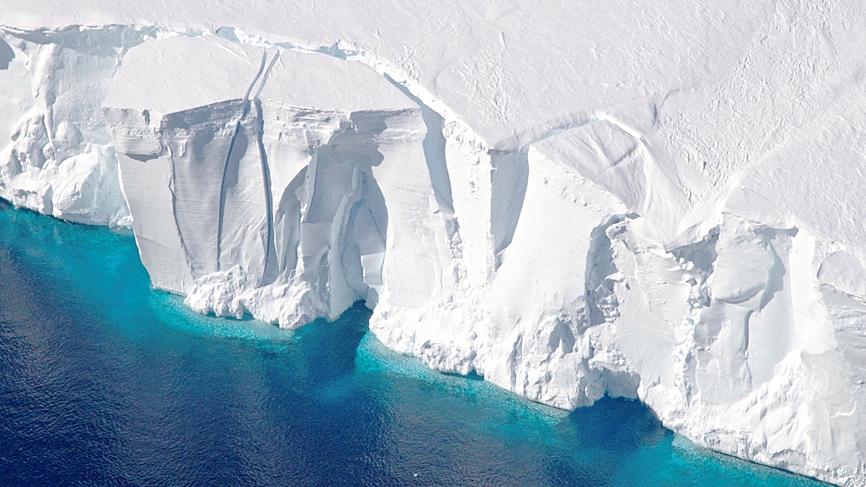Antarctica’s coastal glaciers are shedding icebergs more rapidly than nature can replenish the crumbling ice, doubling previous estimates of losses from the world’s largest ice sheet over the past 25 years, a satellite analysis showed on Wednesday.
The first-of-its-kind study, led by researchers at NASA’s Jet Propulsion Laboratory (JPL) near Los Angeles and published in the journal Nature, raises new concern about how fast climate change is weakening Antarctica’s floating ice shelves and accelerating the rise of global sea levels.
The study’s key finding was that the net loss of Antarctic ice from coastal glacier chunks “calving” off into the ocean is nearly as great as the net amount of ice that scientists already knew was being lost due to thinning caused by the melting of ice shelves from below by warming seas.

Photo: Reuters
Taken together, thinning and calving have reduced the mass of Antarctica’s ice shelves by 12 trillion tonnes since 1997, double the previous estimate, the study said.
The net loss of the continent’s ice sheet from calving alone in the past quarter-century spans nearly 37,000km2, an area almost the size of Switzerland, said JPL scientist Chad Greene, the study’s lead author.
“Antarctica is crumbling at its edges,” Greene said in a NASA announcement of the findings. “And when ice shelves dwindle and weaken, the continent’s massive glaciers tend to speed up and increase the rate of global sea level rise.”
The consequences could be enormous. Antarctica holds 88 percent of the sea level potential of all the world’s ice, he said.
Ice shelves, permanent floating sheets of frozen freshwater attached to land, take thousands of years to form and act like buttresses holding back glaciers that would otherwise easily slide off into the ocean, causing seas to rise.
When ice shelves are stable, the long-term natural cycle of calving and regrowth keeps their size fairly constant.
In recent decades, though, warming oceans have weakened the shelves from underneath, a phenomenon previously documented by satellite altimeters measuring the changing height of the ice and showing losses averaging 149 million tonnes a year from 2002 to 2020, NASA said.
For their analysis, Greene’s team synthesized satellite imagery from visible, thermal-infrared and radar wavelengths to chart glacial flow and calving since 1997 more accurately than ever more than 50,000km of Antarctic coastline.
The losses measured from calving outpaced natural ice shelf replenishment so greatly that researchers found it unlikely Antarctica can return to pre-2000 glacier levels by the end of this century.
The accelerated glacial calving, like ice thinning, was most pronounced in West Antarctica, an area hit harder by warming ocean currents.
However, even in East Antarctica, a region whose ice shelves were long considered less vulnerable, “we’re seeing more losses than gains,” Greene said.
One East Antarctic calving event that took the world by surprise was the collapse and disintegration of the massive Conger-Glenzer ice shelf in March, possibly a sign of greater weakening to come, Greene said.
Eric Wolff, a Royal Society research professor at the University of Cambridge, pointed to the study’s analysis of how the East Antarctic ice sheet behaved during warm periods of the past and models for what might happen in the future.
“The good news is that if we keep to the 2 degrees of global warming that the Paris agreement promises, the sea level rise due to the East Antarctic ice sheet should be modest,” Wolff wrote in a commentary on the JPL study.
However, failure to curb greenhouse gas emissions would risk contributing “many meters of sea level rise over the next few centuries,” he said.

Kehinde Sanni spends his days smoothing out dents and repainting scratched bumpers in a modest autobody shop in Lagos. He has never left Nigeria, yet he speaks glowingly of Burkina Faso military leader Ibrahim Traore. “Nigeria needs someone like Ibrahim Traore of Burkina Faso. He is doing well for his country,” Sanni said. His admiration is shaped by a steady stream of viral videos, memes and social media posts — many misleading or outright false — portraying Traore as a fearless reformer who defied Western powers and reclaimed his country’s dignity. The Burkinabe strongman swept into power following a coup in September 2022

‘FRAGMENTING’: British politics have for a long time been dominated by the Labor Party and the Tories, but polls suggest that Reform now poses a significant challenge Hard-right upstarts Reform UK snatched a parliamentary seat from British Prime Minister Keir Starmer’s Labor Party yesterday in local elections that dealt a blow to the UK’s two establishment parties. Reform, led by anti-immigrant firebrand Nigel Farage, won the by-election in Runcorn and Helsby in northwest England by just six votes, as it picked up gains in other localities, including one mayoralty. The group’s strong showing continues momentum it built up at last year’s general election and appears to confirm a trend that the UK is entering an era of multi-party politics. “For the movement, for the party it’s a very, very big

ENTERTAINMENT: Rio officials have a history of organizing massive concerts on Copacabana Beach, with Madonna’s show drawing about 1.6 million fans last year Lady Gaga on Saturday night gave a free concert in front of 2 million fans who poured onto Copacabana Beach in Rio de Janeiro for the biggest show of her career. “Tonight, we’re making history... Thank you for making history with me,” Lady Gaga told a screaming crowd. The Mother Monster, as she is known, started the show at about 10:10pm local time with her 2011 song Bloody Mary. Cries of joy rose from the tightly packed fans who sang and danced shoulder-to-shoulder on the vast stretch of sand. Concert organizers said 2.1 million people attended the show. Lady Gaga

SUPPORT: The Australian prime minister promised to back Kyiv against Russia’s invasion, saying: ‘That’s my government’s position. It was yesterday. It still is’ Left-leaning Australian Prime Minister Anthony Albanese yesterday basked in his landslide election win, promising a “disciplined, orderly” government to confront cost-of-living pain and tariff turmoil. People clapped as the 62-year-old and his fiancee, Jodie Haydon, who visited his old inner Sydney haunt, Cafe Italia, surrounded by a crowd of jostling photographers and journalists. Albanese’s Labor Party is on course to win at least 83 seats in the 150-member parliament, partial results showed. Opposition leader Peter Dutton’s conservative Liberal-National coalition had just 38 seats, and other parties 12. Another 17 seats were still in doubt. “We will be a disciplined, orderly